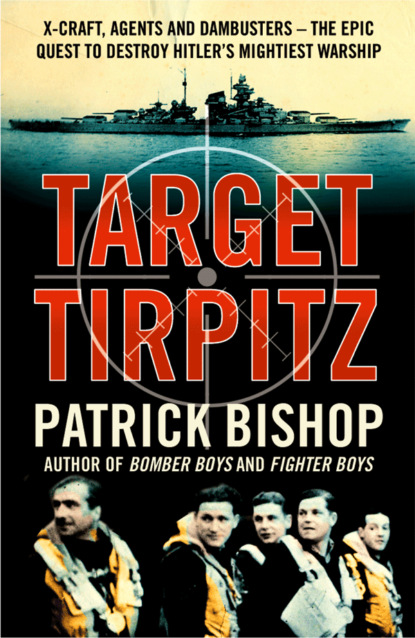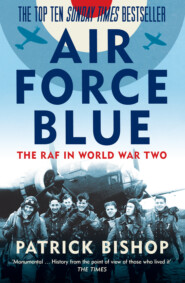По всем вопросам обращайтесь на: info@litportal.ru
(©) 2003-2024.
✖
Target Tirpitz: X-Craft, Agents and Dambusters - The Epic Quest to Destroy Hitler’s Mightiest Warship
Настройки чтения
Размер шрифта
Высота строк
Поля
One Albacore of 832 Squadron and another of 817 Squadron were hit just as they released their torpedoes and tumbled into the sea. There was no chance of rescue by the fleeing battleship and all six on board were killed or drowned.
Despite the furious defence they encountered, the attackers came remarkably close to scoring a hit. According to the Tirpitz log, three of the torpedoes went wide, but a fourth passed ten yards from the stern. A near miss, though, counted for nothing. The determination and sacrifice was in vain. No damage had been done to the target. The only German casualties of the attack were three men wounded by machine-gun fire from the Albacores.
As the torpedo planes dwindled into the distance, relief swept the ship. The decks jingled with shell cases. In the brief action, Tirpitz’s sixteen large-calibre 105mm flak guns, the size of field artillery, had fired off 345 rounds. The 37mm light flak guns had got through 897 rounds and the 20mm guns 3,372. The ship’s eight gigantic guns had also been fired in anger for the first time, loosing off two broadsides against their flimsy attackers. Ciliax made amends to Topp for his intervention. ‘Well done, captain,’ he said in front of the rest of the officers on the bridge. ‘You fought your ship magnificently.’ Exercising his prerogative as fleet commander he made an immediate award to Topp of the Iron Cross, taking off his own and pinning it on the captain.
The surviving aircraft arrived back on the carrier at 11.00 a.m. to a cold reception. ‘The processes of debriefing and dissection of the fiasco ended in the surviving crews being mustered on the quarterdeck of Victorious to be addressed by senior officers in a very recriminatory way,’ Charles Friend remembered. ‘We received for our efforts and the loss of six men what can only be described in the naval slang of the time as a “severe bottle”.’ Friend considered his superiors’ disappointment as ‘natural’. But he judged that ‘their humanity seemed to have left them at that time’.
Lucas was criticized by Bovell for launching his attack prematurely. He went on to conclude that ‘all aircraft were deceived by Tirpitz’s large size and dropped their torpedoes at too great a range’.
A fairer criticism would have been of the system which placed Lucas in charge, even though he had received no training for such an operation and had never flown in action with his men before that day. In the judgement of the official historian of the war at sea, ‘to be called on to carry out so critical an operation in such circumstances was a very severe, even unfair test’.
It was, as Tovey had said, a wonderful chance. But God was not on his side that day and the opportunity had been lost. For a few hours Tirpitz had been uniquely vulnerable, in open sea, with only her own guns and those of a single destroyer to defend her. There was some consolation in the safe arrival of PQ.12 at Murmansk on 12 March. But weighed in the scales of war, Tovey regarded the sinking of Tirpitz as ‘of incomparably greater importance … than the safety of any convoy’. To him the battleship remained a mortal menace, whose removal was worth gamble and risk.
The moment had passed and there was no knowing when it would come again. As Tirpitz slipped into the safety of the sheltered anchorage at Bogen, near Narvik, the Home Fleet, with Victorious, headed disconsolately back to Scapa Flow.
The game was not quite over. The Bogen Bay anchorage provided only a temporary haven. If she lingered, Tirpitz could find herself bottled up by a blockading force stationed at the exit where the narrow Vestfjord met the sea, and vulnerable to air attack. Group Headquarters in Kiel ordered her back to Trondheim. She left at eleven o’clock on the night of 12 March, accompanied by five destroyers. They had been due to sail early on the 13th, but Topp, chastened perhaps by the near miss of the torpedo, superstitiously brought the departure forward.
They picked their way through the inner leads and raced south, through foggy seas, keeping a watch for mines. Though those on board did not know it, there were other dangers lurking. Once again Ultra had given warning of the movement. A flotilla of eight destroyers from Scapa Flow arrived off the coast between Bodø and Trondheim at 1.30 a.m. and steered north into the path of the oncoming Tirpitz. By 3.30 a.m., they had to turn away, so as to be clear of the coast when dawn came up, exposing them to Luftwaffe attack.
Tirpitz steamed southwards, hugging the coast through fog and snow, passing close to four waiting submarines deployed tactically at points along the way where she had to leave the shelter of the leads for the open sea. By nine o’clock on the evening of 13 March, she was back in her anchorage in Faettenfjord. The thick weather persisted. It was not until six days later that a reconnaissance flight confirmed that Tirpitz had returned home.
The failure to nail Tirpitz was badly received in Downing Street. On 13 March, Churchill sent Pound a message asking him to ‘kindly let me have a report on the air attack on TIRPITZ, explaining how it was that 12 of our machines managed to get no hits as compared with the extraordinary efficiency of the Japanese attack on PRINCE OF WALES and REPULSE’.
The underlying explanation, as he knew well, was that the Japanese had the aeroplanes and weapons to wage successful war at sea. The FAA was paying the price of its neglect. Its aircraft were outmoded and outclassed and, in the rapid expansion now going on, training had been rushed and units diluted with untested new arrivals. The debacle hastened efforts to repair these weaknesses, so that the next time the FAA met the Tirpitz the results would be different. In the meantime, Churchill could take satisfaction from an operation that was very much to his taste.
Chapter 6 ‘A somewhat desperate venture’ (#ulink_b05f2ce3-cb51-5277-921a-8ece1219b4c9)
Tirpitz and all the Kriegsmarine’s other large units were now grouped in northern waters, but at the Admiralty the fear persisted that at some point they would return to the Atlantic. If they did, the expectation was that they would then make their base in France. The journey home after a raiding expedition, for refit and repair, would be extremely hazardous. It would make more sense to operate from ports on the Bay of Biscay, and in particular St Nazaire.
St Nazaire lies five miles along the northern bank of the mouth of the Loire where it meets the Atlantic Ocean. It housed a complex of reinforced concrete pens from which German U-boats sallied out against Allied shipping. It was also home to the world’s biggest dry dock, built between 1928 and 1932 for the construction of the great French luxury liner SS Normandie. The dock was the only one on the Atlantic coast large enough to handle a big battleship. It was where Admiral Lütjens had been heading when the Bismarck was damaged and was the obvious place from which Tirpitz could lunge at the transatlantic convoys.
Hitler by now had no intention of risking Tirpitz on a long-range mission. Räder agreed with him. Her performance against PQ.12 was disappointing. Nonetheless, she was providing a great service tying up a large portion of the Home Fleet which otherwise might be operating to greater effect in the Mediterranean or Far East. U-boats were, anyway, sinking large amounts of transatlantic Allied shipping every day without any help from the surface fleet – 1.2 million tons were lost in the first three months of 1942.
In these circumstances, the U-boat pens at St Nazaire would appear a more vital target than the dry dock. The port had already been subjected to air attack. In the spring of 1941, as the crisis of the Battle of Britain faded and the Battle of the Atlantic intensified, Churchill had demanded a maximum effort from the RAF against the two enemy weapons that were wreaking most of the destruction. His words were repeated in the directive handed to Bomber Command: ‘We must take the offensive against the U-boat and the Focke-Wulf (Condor) wherever we can and whenever we can.’
St Nazaire was listed as a target. It was not until the next year that regular raids were launched. The bombing was inaccurate and ineffective and operations were restricted by Churchill’s instruction that aircraft were to attack only when visibility was good enough to minimize the risk to French civilians. A chance had been missed. By March 1942, nine out of fourteen planned submarine pens were finished. Shielded from bombs by massive layers of ferro-concrete, there was no hope of destroying them from the air. A land attack would take enormous resources and involve considerable losses.
The pens, then, were too tough a target, whichever way they were approached. The Normandie dock, however – even in the changed circumstances of early 1942 – still appeared a worthwhile proposition. The shift of all Hitler’s big ships northwards that was completed with the Scharnhorst and Gneisenau’s dash through the Channel had not been interpreted in the Admiralty as meaning that the Kriegsmarine’s surface ships would no longer venture south.
Fear of the Tirpitz’s destructive capabilities remained as intense as ever. As long as the facilities at St Nazaire were intact, the possibility existed that a raiding force with Tirpitz at its heart would launch into the North Atlantic, laying waste to the convoys and diverting most of the Home Fleet into the effort to hunt it down. The destruction of the Normandie dock would shut down that possibility for ever.
In January 1942, following a conversation with Churchill, Sir Dudley Pound asked the Admiralty’s Plans Division to examine the possibilities. They in turn asked the newly appointed Chief of the Combined Operations Headquarters, Lord Louis Mountbatten, to devise a solution. Combined Ops was an inter-service organization tasked with devising disruptive raids that would harry and unnerve Axis forces. It could call on the troops of the Special Service Brigade’s Commandos, set up after the fall of France by Churchill to ‘develop a reign of terror down the enemy coast’. But it had no real resources of its own and was dependent on the cooperation of the other services, which was by no means automatically forthcoming.
Over the next weeks Mountbatten and his team drew up a plan of outrageous boldness. It depended on speed, surprise and devastating force and was just the sort of operation that delighted Churchill, appealing to his romantic weakness for the dash of pre-industrial-era soldiering. If successful, it would have very welcome psychological as well as material results. With the Soviet Union and the United States as allies, Britain was no longer alone. On land and sea, though, the war was not going well. As Commander Robert Ryder, who would lead the naval force in the attack, observed, ‘some feat of arms that would hearten the country in such a dark hour’ was an added good reason for the great risks involved.
The Normandie dock was 1,148 feet long and 164 feet wide with lock gates, known as caissons, at each end. It ran at a slant with one end opening into an inner port basin, the Bassin de Penhoët. The other connected to the river. The caissons were made of hollow steel sections and were thirty-five feet thick.
The basic plan was to sail an old destroyer, the Campbeltown, accompanied by eighteen shallow-draught launches, up the Loire estuary to St Nazaire and drive her at full speed through the lock gates. Next, 277 commandos, split into eighteen teams, would set about destroying the dock machinery. Then, time-delayed fuses would detonate the four and a half tons of Amatol high explosive packed into the Campbeltown, destroying the dock.
The commandos at the heart of the operation were all volunteers, dedicated, skilful and aggressive. In the six weeks they had to prepare, the teams trained with an intensity that reflected the hardening professionalism and determination of the British war effort, carrying out dummy runs in the port facilities at Cardiff and Southampton. In Southampton they had the advantage of familiarizing themselves with the King George V Dry Dock which was an almost exact replica of the one they were going to attack.
The force was led by Lieutenant Colonel Charles ‘Charlie’ Newman of 2 Commando, which provided most of the troops. Newman was an amiable and good-natured thirty-seven-year-old, who was married with four children and a fifth on the way. He had been a successful civil engineer before the war, though, as well as a Territorial Army officer. Much of the rest of his spare time was spent playing rugby, golf and the piano. He smoked a pipe and reminded one of his young volunteers of a ‘benign elephant … due to the downward curve of his prominent broken nose’, the result of his time as an amateur boxer.
A week before the operation was due to begin, Newman returned from a meeting with the Chief of Combined Operations and addressed his commandos frankly. One of his men recalled him telling them that Mountbatten was confident that they would ‘get in and do the job’. He made it clear, though, that ‘we cannot hold much hope of you getting out again’. Newman also passed on Mountbatten’s offer that ‘any man could volunteer out of the forthcoming operation should he wish to do so. Charlie though was wasting his time … Everyone stayed put, satisfied in their work and of course labouring under that strange illusion – their own immortality.’
The flotilla set off from Falmouth on the afternoon of 26 March, escorted by two destroyers. The Campbeltown was in her second incarnation. In her previous life she had been USS Buchanan of the United States Navy and had been transferred to Britain as part of the Destroyers for Bases Agreement, earlier in the war. She was captained by Lieutenant Commander Stephen ‘Sam’ Beattie, a thirty-three-year-old Welshman who was to win the Victoria Cross for his part in the raid. The rest of the flotilla was made up of sixteen wooden-hulled motor launches, one small MGB (motor gunboat) and one MTB (motor torpedo boat) to provide covering fire and to evacuate the survivors of the raiding party.
The raid was to open spectacularly with the Campbeltown driving at full speed into the southern caisson, lodging herself firmly in the middle of the structure to cause maximum devastation when the twenty-four Mk VII depth charges she was carrying, each weighing 400lb, exploded. They were packed into a steel tank and concreted over and fitted with long-delay fuses timed to detonate after eight hours.
Then it was the turn of the commandos. The teams were divided into three groups, one on the Campbeltown and the other two on the launches. They were to storm ashore and set about their demolition tasks. Each team was divided into two, with one half laying their charges while the others held off the defenders with guns and grenades.
The force on board Campbeltown had the mission of wrecking the machines that operated the Normandie dock – the pumphouse and winding sheds that filled and emptied the basin. They were also tasked with destroying the northern caisson. The other two groups were to be landed to the west at the Old Mole and the Old Entrance to smash up bridges and locks. In the unlikely event of the operation going perfectly to plan, they would then seal off the area to allow an orderly evacuation on the motorboats. Finally, the flotilla’s MTB was to fire torpedoes at the lock leading to the main dock, the Bassin de St Nazaire, on which the submarine pens lay.
The mission bordered on the suicidal as all who took part in it knew. Major Bill Copland, Newman’s second in command and a forty-four-year-old veteran of the First World War, who was leading the group embarked on the Campbeltown, spelled out the likely consequences in a farewell letter to his wife Ethel. ‘My dearest,’ he wrote. ‘I have to write this letter although God knows I hope you never receive it – which you only will if I don’t come back. We sail in a day or two on a somewhat desperate venture, but one of high purpose. If we succeed, and only the worst of ill-luck will stop us, then we shall have struck a great blow for the cause of freedom. Remember too that if I do get blotted out I shall probably die in good company, for never did a finer crowd set out on a doughtier task.’
The force sailed south-west, across the English Channel, then south round the Brittany Peninsula and into the Bay of Biscay, taking a meandering route and keeping well out to sea to disguise their ultimate destination. The Campbeltown had been given a quick cosmetic refit to try and alter her lines to something resembling a German warship, reducing her four funnels to two. All in the flotilla flew Kriegsmarine ensigns, weathered and tattered for authenticity.
The assumption was that sooner or later they would be spotted by an enemy vessel or aeroplane and on the morning of the 27th they were. They were 160 miles south-west of St Nazaire and just turning back towards the coast when they sighted a U-boat that was making its way back to port. One of the destroyers gave chase and dropped depth charges but the submarine got away. Its radio message reporting the encounter led the German naval command onshore to conclude that the British force was on passage to Gibraltar or on a minelaying mission.
The expedition’s luck had held but the hazards were only just beginning. Even with surprise on its side the risk of catastrophe was high. The area around St Nazaire was heavily protected by gun emplacements operated by German naval troops. To reach St Nazaire they had first to sail past the heavy seaward defences set up at the mouth of the Loire. There were forty-three guns ranging from 75mm artillery pieces to hefty 240mm howitzers mounted on railway trucks. Closer to the port they would face flak batteries equipped with 40mm, 37mm and 20mm cannon. The port itself was defended by a thousand men and studded with pillboxes and strongpoints, while harbour defence boats patrolled the waters outside. The whole area could be lit up at night by searchlights sweeping the docks and waterways. If the men charged with the defence of St Nazaire failed in their duty there were another 5,000 German troops based in the town to fall back on.
The purpose of all these precautions was not, however, solely to protect the Normandie dock. In the minds of the Germans, the most important potential target were the submarine pens which lay on the west side of the Bassin de St Nazaire, surrounded by flak batteries and searchlights.
Moored inside the pens were the craft of the 7th Submarine Flotilla. More U-boats were on the way and the facilities were being extended to accommodate the 6th Flotilla which was in the process of transferring from the Baltic. The day before the raid, the officer commanding the U-Boat fleet, Vizeadmiral Karl Dönitz, had inspected the defences together with the commander of the 7th Flotilla, Kapitänleutnant Herbert Sohler. He asked him what he would do if the ‘English’ attacked. Sohler replied that it was ‘out of the question’ as they would never be able to reach the harbour’.
On the evening of 27 March, the attacking force turned to make its last approach and headed towards the mouth of the Loire. The destroyer escorts slid away and the raiders were on their own. They were led by the MGB with Colonel Newman and Commander Ryder on board. Immediately behind came Campbeltown with the other motor launches arrayed in two columns on either side with a tail of three bringing up the rear. Most were wooden-built Fairmile ‘Bs’. They were 112 feet long and nearly twenty feet wide and their two 600-horsepower engines could push them through the water at twenty knots. Extra guns had been fitted for the operation. They had two 20mm Oerlikon cannons mounted fore and aft with two .303 machine guns on the bridge.
As the little fleet progressed, those on board could hear the rumble of explosions. A bombing raid was included in the plan, timed for just before midnight. It was a diversionary effort with thirty-five Whitleys and twenty-seven Wellingtons taking part. According to Ryder, ‘it was hoped that under the general confusion caused by this air raid, directed right on the waterfront, our landing would be comparatively unopposed’. However, in keeping with Churchill’s concerns about French civilian casualties, the crews were under instruction to bomb only if they could see their targets. The blanket of cloud made identification impossible. Only four aircraft dropped their bombs and the main result of the raid was to sharpen the Germans reflexes and arouse their suspicions.
‘In effect, the raid raised the alarm,’ wrote Ryder later. ‘Every gun was manned; patrols, fire parties and others had fallen in, and the gun control and look out system [was] thoroughly on the alert … thus the surface attackers reaped every disadvantage in having their attack heavily opposed by an enemy fully prepared.’
Вы ознакомились с фрагментом книги.
Приобретайте полный текст книги у нашего партнера:
Приобретайте полный текст книги у нашего партнера:











